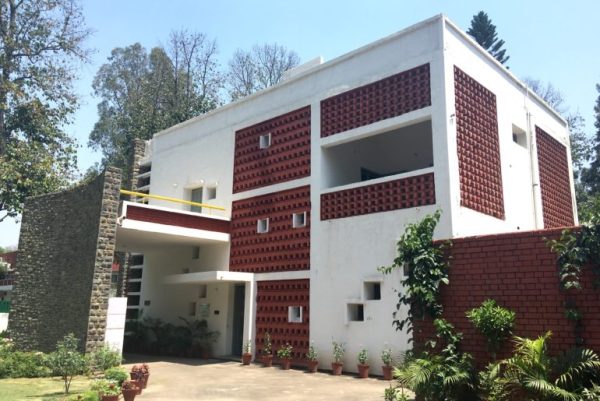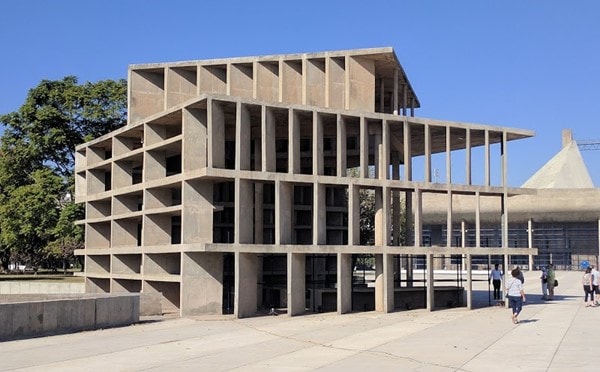Updated: June 13, 2022 12:00:27 am
 Mud houses before 1951 in Chandigarh villages.
Mud houses before 1951 in Chandigarh villages.Climate responsiveness was one of the most important aspects considered by Swiss-French architect Le Corbusier throughout the planning and design of the city of Chandigarh. The decision regarding the exact location and orientation of the city went through multiple deliberations based on the idea of creating a natural microclimate for a region having a hot and dry climate for a majority of the year.
Chandigarh was thus designed at the foothills of the Shivaliks bound by two river beds about five miles apart – the Patiala ki Rao to the west and the Sukhna Choe to the east – and with the natural green belts incorporated within the planning. In addition, rows of mango trees were planted as a green belt to check the unrestricted sprawl of large built-up areas and to provide an efficient buffer between the city and its industrial area. Thus, conditions like the topography, natural vegetation and availability of water guided the nuances of Chandigarh. Corbusier emphasized understanding the role of natural elements like sun, space and verdure that not only enhance the man-made environment but also fulfill climatic responsive principles for a city.
 An example of climate-responsive architectural vocabulary designed for Chandigarh.
An example of climate-responsive architectural vocabulary designed for Chandigarh. The team of architects also observed the vernacular architecture of the region before creating their models for climate-responsive architecture. The mud houses of the existing villages showed them how the strategic location and sizes of openings helped the residents to create a comfortable living environment in their abodes. These inspirations were taken and evolved in form of various shading devices and window typologies designed specifically for Chandigarh. For example, Pierre Jeanerette, Maxwell Fry and Jane Drew designed frame control restrictions that specified types and sizes of window frames, verandahs, courtyards, brick jalis, etc. The team wanted to control the effect of the sun on all four sides of a building to reduce temperatures within.
Due to budget and time constraints, modern construction materials and techniques needed to be considered for the new capital city. The city is mostly built in brick, stone and shutter finish concrete. To understand climate responsiveness through these materials, all the building elements were experimented upon and refined in the present Le Corbusier Centre (Sector 19) before execution so that a sustainable form and attitude of the building was determined.
Best of Express Premium
Le Corbusier also designed a ‘Tower of Shadows’ in the Capitol Complex precisely aligned on the north-south axis with the north side completely open and the other three sides having Brise-soleil (sun breakers) like vertical shading devices set at different angles and horizontal shading devices having different depths. Where the cross walls provide protection when the sun is low on the horizon, the wing walls block the sun’s rays.
The ‘Tower of Shadow’ was a demonstration to trace the path of the sun using shadows cast on both sides of the tower. It, therefore, defines the architectural vocabulary of Chandigarh through details of sunshades, fenestrations (arrangement of windows), parasols, louvers (blinds with horizontal slats), verandahs, brick jalis and courtyards, all aimed at natural climate control at the micro-level. For instance, the shopping street of every sector has shops on the south side with deep corridors so that pedestrians can walk in the shade during daytime and brick jalis on the façade that act as sunbreakers. The buildings along Madhya Marg witness dead façades which minimise heat gain inside the building.
The thermal comfort of users in outdoor spaces is also an important aspect catered to in Chandigarh. The Sukhna Choe was dammed to create an artificial lake in the eastern part of the city to enable evaporative cooling so that the surrounding areas experience a pleasant breeze. Small water bodies near important sites like the high court, Assembly, Gandhi Bhawan, etc, were added for the same reason. The effectiveness is enhanced by careful placements of these water bodies as per prevailing wind movement and minimum run-off discharge from the site during monsoons.
 The ‘Tower of Shadow’ was designed by Le Corbusier to study solar movement, to explain the theory that sunlight could be controlled within the four sides of a building.
The ‘Tower of Shadow’ was designed by Le Corbusier to study solar movement, to explain the theory that sunlight could be controlled within the four sides of a building. The planned parks in every sector, tree plantations on either side of all major dividing roads and reserved forest areas also help reduce the negative impacts of an urban heat island that is being created right now in Chandigarh. For example, the plantation along Jan Marg consists mostly of Chukrasia tree which was done so that the trees’ foliage cuts the evening sun rays and helps employees to comfortably commute from the Capitol Complex and government offices to residential sectors.
As Chandigarh completes nearly 70 years of existence, it is witnessing rapid urbanisation and the problems that come with it. Factors like traffic congestion, urban heat island, greenhouse gas emissions and climate change are pressing concerns. Mainly concrete has been used as a building material and hardscape material for landscaping. Concrete traps a lot of heat and makes it uncomfortable to walk during daytime in summer. The climate is changing and the temperatures are soaring. Since the buildings are made of reinforced concrete and are without any insulation treatment, they are unable to maintain the thermal comfort within buildings.
We have to heavily rely on the cooling appliances which may cool down the indoor environment but put a heavy impact on the outdoor environment that ultimately leads to climate change in some manner. In a green city like Chandigarh, it is disheartening that the city which was designed for both the pedestrian and vehicular traffic is now heavily dominated by vehicles. This trend of rise of motor vehicles in the city compared to the population is one of the reasons for the rise in temperature. If we ignore these facts, city people will really have to face bigger consequences in the coming days.
🚨 Limited Time Offer | Express Premium with ad-lite for just Rs 2/ day 👉🏽 Click here to subscribe 🚨
In conclusion, it is suggested that the residents consider solar passive architecture techniques while building, encourage greenery in their environments and make the city pedestrian and bicycle-friendly, at least for shorter commutes. Chandigarh, as a climate-responsive city, needs to learn a lesson from the past and adopt new technology to deal with climate change in future without compromising Le Corbusier’s design philosophy.
(The authors: Ar Vijay Kumar is an Assistant Professor at Chandigarh College of Architecture (CCA) and Gautam Jha is a second-year M.Arch student. This article, edited by Ar Saumya Sharma, Assistant Professor at Chandigarh College of Architecture, is part of a fortnightly series by the students and faculty of CCA on the Making of Chandigarh for the Le Corbusier Pierre Jeanneret forum.)
- The Indian Express website has been rated GREEN for its credibility and trustworthiness by Newsguard, a global service that rates news sources for their journalistic standards.

